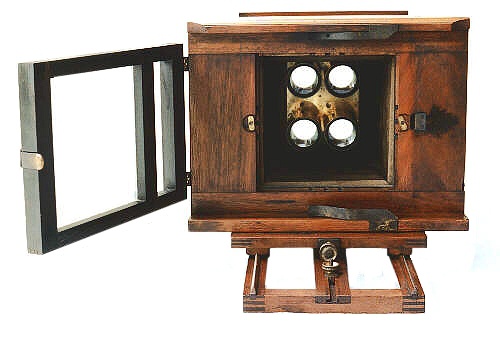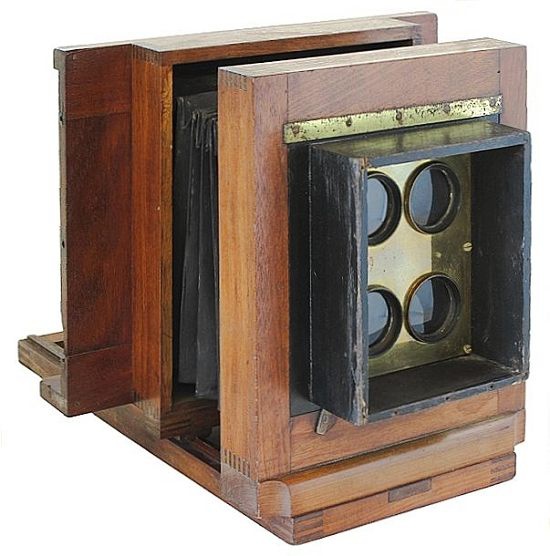|
|



Copyright ©2002 by Rob Niederman - ALL RIGHTS RESERVED
Visit the Andre Adolphe Disderi Reference page
Visit the 9-Lens "Gem" Wet Plate Camera page
Return to the Multiple Lens Cameras page
Visit the 9-Lens "Gem" Wet Plate Camera page
Return to the Multiple Lens Cameras page
Carte de Visite photographs are small prints
mounted on cards that are roughly 2-1/2 by 4
inches. The predecessors of the Carte de Visite
were calling cards. Calling cards were used in the
same manner as today's business card but were
slightly smaller.
In 1854, Andre Adolphe Disderi was the first to devise a way to make Carte de Visite multiple images or portraits on a single photographic plate. This called for a new type of camera with a shifting back. Each time the back was moved, a different portion of the plate would be exposed allowing a set of several images to be printed at the same time.
Some cameras used anywhere from 2 to 32 lenses while still others had both shifting backs and multiple lenses. These cameras soon were referred to as Multiplying Cameras and were very efficient at producing numerous images in a short period of time. Multi-lens and multiplying cameras were popular from the mid-1850s to 1870s and continued to be made through the early 1900s.
Wet plate, multi-lens cameras are rare and prized items. The wet collodion process required that a plate be coated just before taking a picture. The entire process of coating the plate, taking the picture, and developing the image had to be accomplished while the collodion was still liquid (wet). Regardless of how careful a photographer tried to be, the collodion would always drip through the plate holder and inevitably get on the camera. The presence of stains is considered a desirable "badge of honor" and adds character to the camera's appearance.
In 1854, Andre Adolphe Disderi was the first to devise a way to make Carte de Visite multiple images or portraits on a single photographic plate. This called for a new type of camera with a shifting back. Each time the back was moved, a different portion of the plate would be exposed allowing a set of several images to be printed at the same time.
Some cameras used anywhere from 2 to 32 lenses while still others had both shifting backs and multiple lenses. These cameras soon were referred to as Multiplying Cameras and were very efficient at producing numerous images in a short period of time. Multi-lens and multiplying cameras were popular from the mid-1850s to 1870s and continued to be made through the early 1900s.
Wet plate, multi-lens cameras are rare and prized items. The wet collodion process required that a plate be coated just before taking a picture. The entire process of coating the plate, taking the picture, and developing the image had to be accomplished while the collodion was still liquid (wet). Regardless of how careful a photographer tried to be, the collodion would always drip through the plate holder and inevitably get on the camera. The presence of stains is considered a desirable "badge of honor" and adds character to the camera's appearance.
Multi-Lens Cameras | View Cameras | Self-Casing Cameras | Solid Body Cameras | References & Advertisements
Home | What's New | Show Schedule | Wanted | For Sale | Links | Site Map | Email
Home | What's New | Show Schedule | Wanted | For Sale | Links | Site Map | Email
1860s Scovill (possibly Peck) style wet-
plate camera with four Darlot No.4 lenses.
plate camera with four Darlot No.4 lenses.
Collodion stains are very evident on the large brass
plate-holder retaining springs and wood. Heavy brass
tarnishing and large stains on the wood back would
indicate that this particular camera earned its keep.
The original wood color can also be seen as the lighter colored vertical area to the right of the lens chamber. A wide back allowed the photographer to reposition the wet plate-holder for multiple images.
The original wood color can also be seen as the lighter colored vertical area to the right of the lens chamber. A wide back allowed the photographer to reposition the wet plate-holder for multiple images.
4-tube Carte de Visite Wet Plate Camera, 1860s
Unknown American Maker (possibly Samuel Peck)
Unknown American Maker (possibly Samuel Peck)
